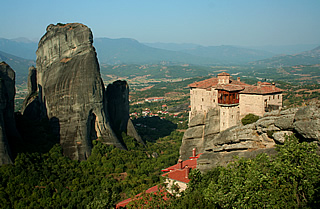

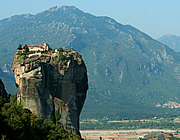
Travelling through this most ancient of European civilised lands to see the birthplace of Philip II, father of Alexander, and its wonderful mosics, his burial site beneath a protective tumulus, and the magnificent frescoed monasteries of Meteora on their pinnacles of rock.
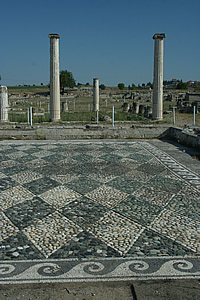
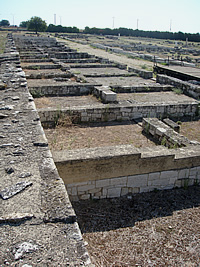
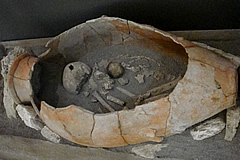
Leaving Thessaloniki our first destination was Pella. Though the site has been occupied since the Early Bronze Age, around 3000BC, the classical Greek city is best known as the birthplace of both Philip II of Macedon and his rather more famous son, Alexander the Great.
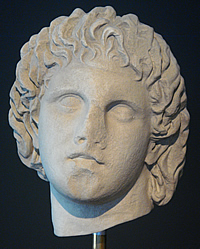
King Archelaos made this the capital of Macedonia in the late fifth century BC. It is laid out in a grid - the Hippodamean system, as exemplified at Olynthos on the Halkidiki peninsula. There are some extremely fine pebble mosaic pavements - some in situ and others in the excellent small museum in the nearby town. There were a good few archaeologists working on the site while we were there so it is very much a work in progress.
Philip was born here in 382 BC and his son in 356 BC. They were both great warriors and Philip began a series of wars with the city states of Greece eventually forming the League of Corinth, after victory at the Battle of Chaironeia in 338 BC against Athens and Thebes - two of the most influential. His plan was for the allies to launch a war against the troublesome Persians but he was assassinated before this could be achieved. Instead his son Alexander, at 20 years old, became king of Macedon, quickly putting down the rebellions which had erupted on Philip's death. He then marched 40,000 men into Asia Minor and conquered Syria, Palestine and Egypt and ultimately defeated the Persian King Darius in 331 BC, the subject of the famous mosaic now in the Naples Museum. He continued as far as northern India, but his soldiers were weary - they'd been away from home continuously for ten years. He settled in Babylon in Mesopotamia where he died of a sudden illness in 322 BC at the age of 33. His empire was carved up among his generals.
Over the course of the reigns of these two men Greece progressed from a land of many warring city states toward a Hellenistic culture, though still often riven by two warring leagues of cities.
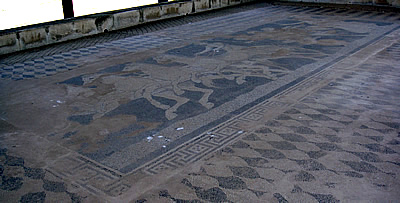
It is rather atmospheric wandering around these ruins. Though mostly only the lower sections of walls, some columns have been restored and small sections of structures replaced to give some impression of what the city was like. Walking in the steps of Alexander - magical!
There are some fantastic mosaics still to be seen in situ, notably the Abduction of Helen by Theseus - at 8.4m long the biggest at Pella, and the Stag Hunt, both late 4th century BC.
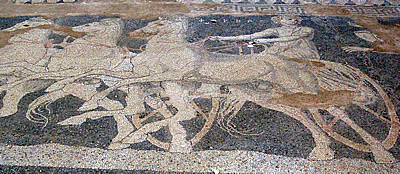
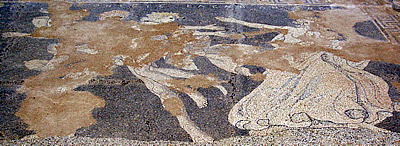
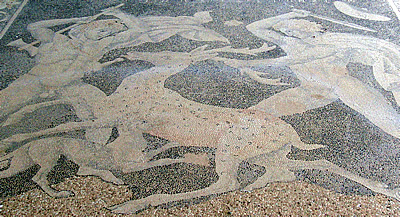
The classical Greek city extended over an area of about 2.5km north south by 1.5km east west, with broad roads between 6 and 9m wide separating the grid layout of buildings. Beneath the roads was a dense network of water and drainage pipes. Water was carried from the mountains via tunnels in the rock to feed the many fountains, wells and cisterns of the city, both in public and private buildings. Smaller homes were of around 200 sq m, larger homes of upto 3,000 sq m in size, with the usual central courtyard and often elaborately decorated rooms with pebble mosaic floors and painted walls.
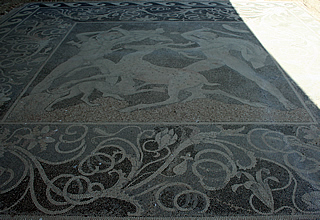

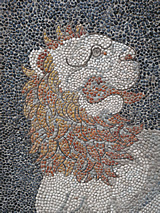
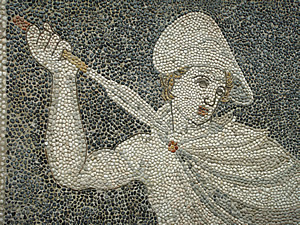
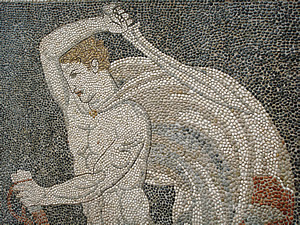
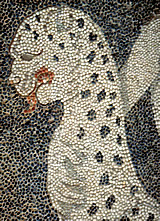
The city also had its royal palace, two sanctuaries - one to the Mother of the Gods and Aphrodite, the other to Darron, public baths - though many houses also had bathing rooms - and the Agora, very large at 70,000 sq m occupying ten building blocks and with a huge open space at its centre approached by what must have been very imposing monumental terraces fronting the adjoining streets. Here was the centre of commercial and administrative activity with shops, workshops, archives and the seat of the local rulers. The city was obviously rich and economically successful. The city was eventually abandoned following a devastating earthquake and fires destroyed many buildings in the early 1st c. BC.
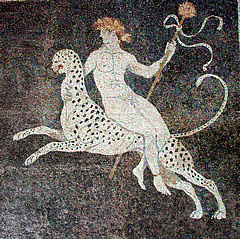
The museum is well worth visiting. It's not huge and is very well laid out. The two late 4th century BC mosaics of the Lion Hunt and Dionysus on the back of a Panther are worth the effort alone. Both were found in the House of Dionysus, at 3160 sq m the largest house in Pella. As well as natural pebbles, artificial coloured pebbles, lead wire and strips of fired clay were also used.
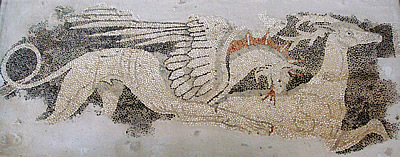
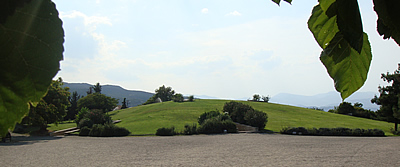
The first capital of Macedonia, this remained the burial site of Macedonian royalty, even after the capital was moved to Pella. 11km south east of Veria (where we had a truly excellent lunch at Eleas Gi) remains of the ancient city and the necropolis have been excavated. At the heart of the necropolis is the Cemetery of the Tumuli with over 300 grave mounds. The Great Tumulus, 110 m in diameter and 13 m high, was investigated at the end of the 1970s and found to contain four royal tombs.
No photography is allowed inside the tumulus, unfortunately. A great shame as it is one of the most atmospheric "museums" we've ever visited and it is difficult to give a good impression of it. It is mostly quite dark inside with judiciously positioned lighting on the tombs and artefacts.
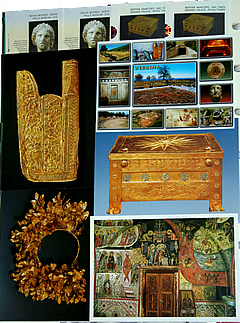
First to be said is that the museum consists simply of the interior of the excavated tumulus, all underground, reached by a downward sloping tunnel. Here are revealed the four tombs beneath the main level of the interior of the tumulus where are displayed beautifully restored artefacts found in the tombs. None of the tombs themselves can be entered by the public.
The first excavated tomb that you look down on is quite large with a Doric style facade, unattributed and completely robbed out in antiquity.
The second excavation is of a funerary temple or Heroön, which has fine wall paintings of the rape of Persephone by Pluto. Here there is a cist tomb, a pit lined and covered with slabs of stone, from where the grave goods had also been stolen.
The third tomb was undisturbed and is identified as that of Philip II, father of Alexander the Great. It was here in Vergina (ancient Aigai) that Philip was assassinated at the wedding of his daughter Cleopatra. The tomb is reached by a steeply descending ramp ending in front of the tomb entrance, a recessed door in a facade with high relief columns, set into the facade rather than free-standing, and a painting of a hunting scene extending the full width of the facade above the door, about five and a half meters. Inside the tomb are two rooms: an antechamber leading to the burial chamber. In the burial chamber was found a solid gold larnax or casket containing the remains of the king and his golden wreath along with his weapons, personal effects and wooden mortuary couch.
The final tomb, also undisturbed, is said to be that of Alexander IV, the son of Alexander the Great. It is similar in design to Philip's, though smaller, and contained a similar array of precious artefacts.
Many of these treasures are displayed in glass cabinets in the main space of the museum including Philip's solid gold larnax, beautiful gold wreath and finely embossed gold quiver - probably for ceremonial use rather than a practical item.
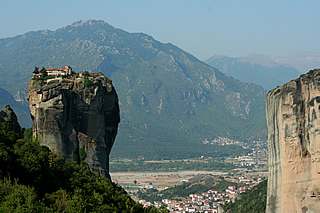
This was what first lured us to Macedonia - Meteora and its amazing monasteries perched on pinnacles of rock. The rock pillars were formed by the erosive action of flowing water on the landscape and in the eleventh century hermits sought out caves here. In the 14th century monks started to form communities in this inaccessible landscape to escape invaders. Ladders were used to help in the ascent of the pinnacles and material for building the monasteries was either carried or hoisted via ropes and baskets or nets.
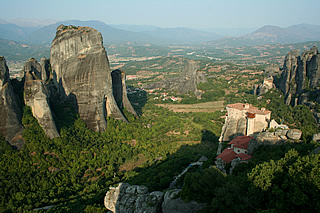
The first monastery to be founded, by St Athanasius from Mount Athos on the Halkidiki peninsula was Grand Meteora. By the end of the sixteenth century there were 24 monasteries, beautifully decorated with colourful frescoes. Today four monasteries and two convents are occupied and can be visited. We found that over a couple of days it was quite possible to visit all six, provided you choose the right days as they are not all open at the same time. None allow photography of their frescoes and all require visitors to be modestly dressed, especially women. Most of the churches consist of two chambers: the narthex or entrance area, and the church proper.
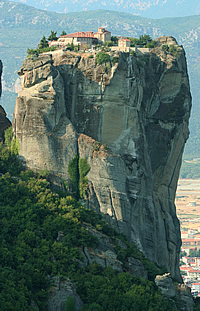
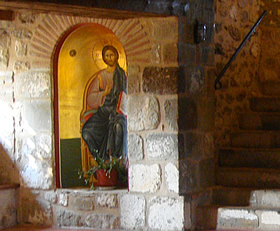
This is probably the most dramatic of the monasteries, on its tall pinnacle of rock. Driving up and parking early one morning we saw a primitive cable car - barely more than a metal box on rope pulleys being used to transport goods and workmen to the monastery. However, we were quickly disabused of the notion that we might use it to cross the ravine and instead pointed to a path which descends then ascends via a long flight of steep steps to the entrance.
It's a small place and only a few monks live here. Its 15th century church has two small rooms, their walls covered with frescoes. On leaving we were both given a small piece of highly scented Turkish Delight.

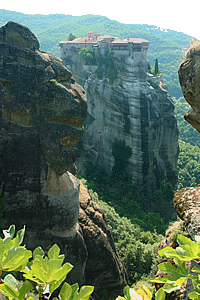
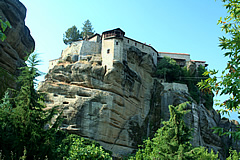
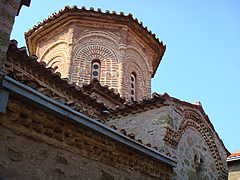
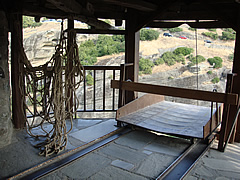
The monastery was founded in 1518 by two brothers on the site of a 14 century hermitage established by a monk called Barlaam.
The frescoes here are particularly good, with a fine Day of Judgement, a popular subject usually depicting the damned disappearing down the fiery throat of a dragon. My favourite fresco shows Alexander the Great as a skeleton in a coffin!
An original rope hoisting net can still be seen here.
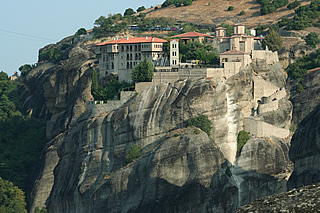
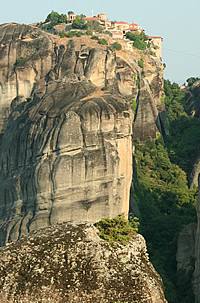
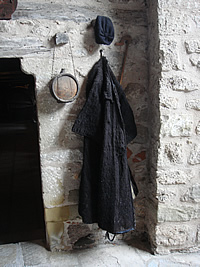
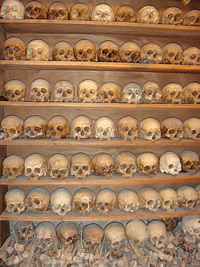
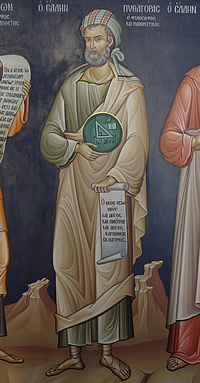
By far the largest of the monasteries, also the oldest, Great Meteoron was founded in the fourteenth century and became rich and powerful when the Serbian emperor Symeon Uros became a monk and gave his wealth to the monastery.
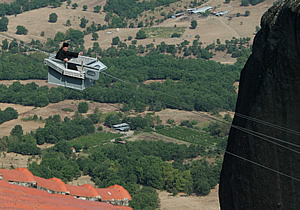
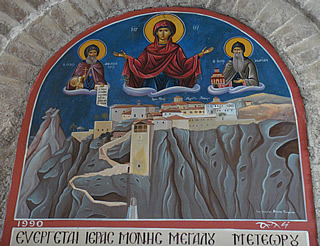
The walls and ceiling of the narthex are covered with many depictions of the gruesome martyrdoms of saints: heads chopped off, heads and limbs sawn off, disembowelling, hanging upside down, burning, stretched around a wheel - very gory!
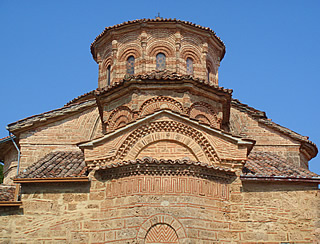
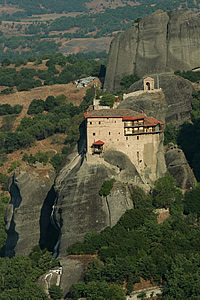
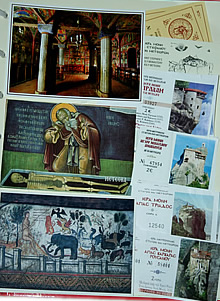
A fifteenth century monastery set in this fabulous landscape, with more beautiful frescoes and one of my favourites "Adam naming the Animals" which can be seen in a postcard in the image of souvenirs on the left. Also another "Day of Judgement" with fiery descent into hell - the mouth of a fearsome creature!
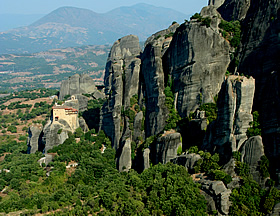
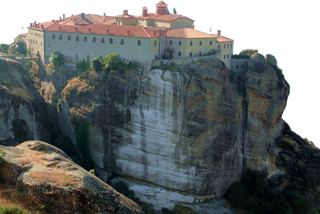
Actually a nunnery, we found that St Stephen's closed for a couple of hours in the afternoon. Founded in the late fifteenth century it has two churches and is very easy to access, via a bridge spanning the gorge between the rock pinnacle on which the monastery sits and the main mass of the mountain. Very jolly nuns in residence.
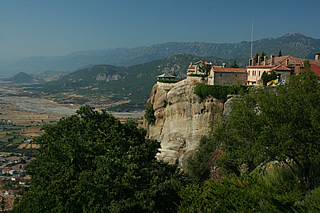
More wonderful frescoes, these fairly modern towards the end of the twentieth century: gory martyrdoms, a Judgement Day and another version with ladders, the sinners being pushed off and falling head first into the gaping mouth of a beast. As in the other monasteries, a plank of wood is used as a sounding board for calls to services, in memory of the one used by Noah to call the animals to the Ark.
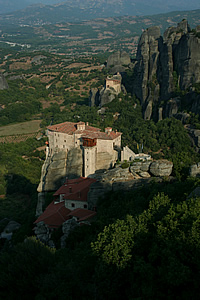
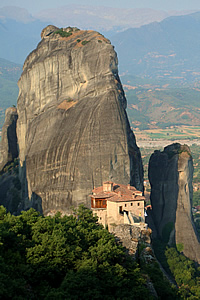
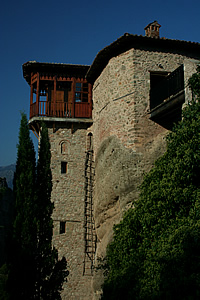
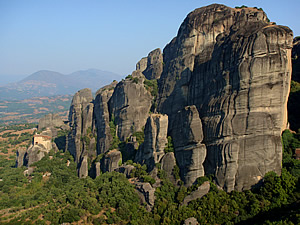
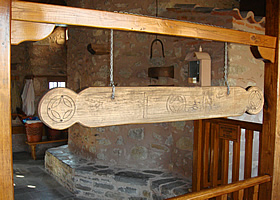
A beautiful small monastery - actually home to nuns - one of the most picturesquely situated in Meteora on its steep sided rock and much photographed from vantage points around the area. Quite a few steps to climb from the roadside car park, but not too bad - also accessible from the road above when you have to tackle a climb back up at the end of your visit.
A jolly nun took our fee - as in all the monasteries 2 Euros each.
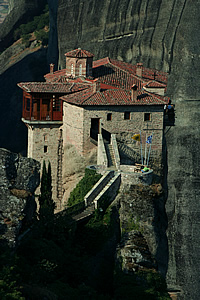
Rousanou is quite small, at least the part accessible to the public - there looks to be more associated buildings nearby. The two chambered church again has fine frescoes of the "Day of Judgement" and martyrdoms.
